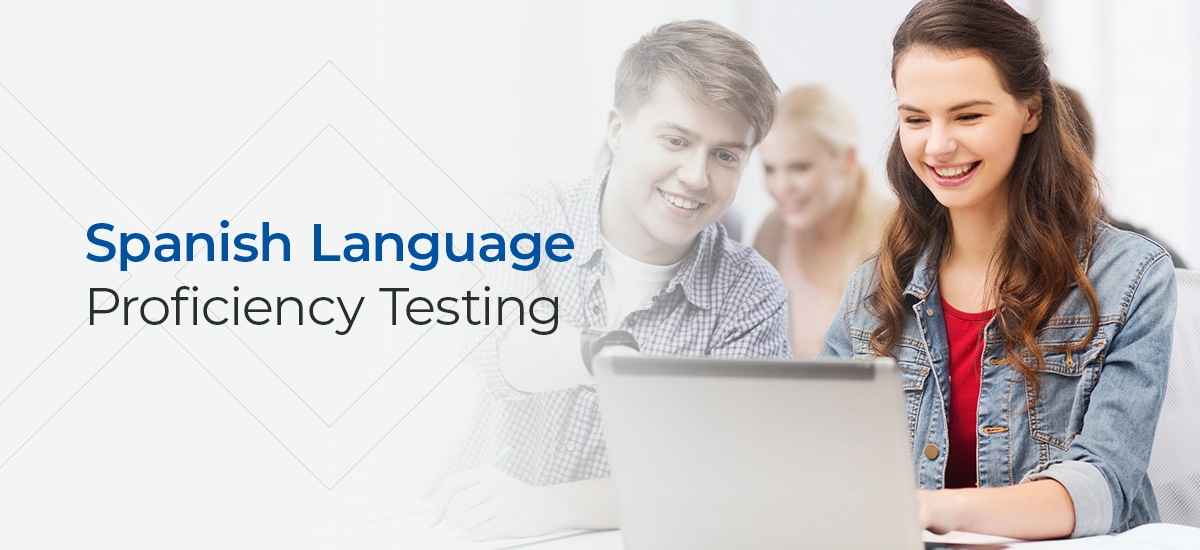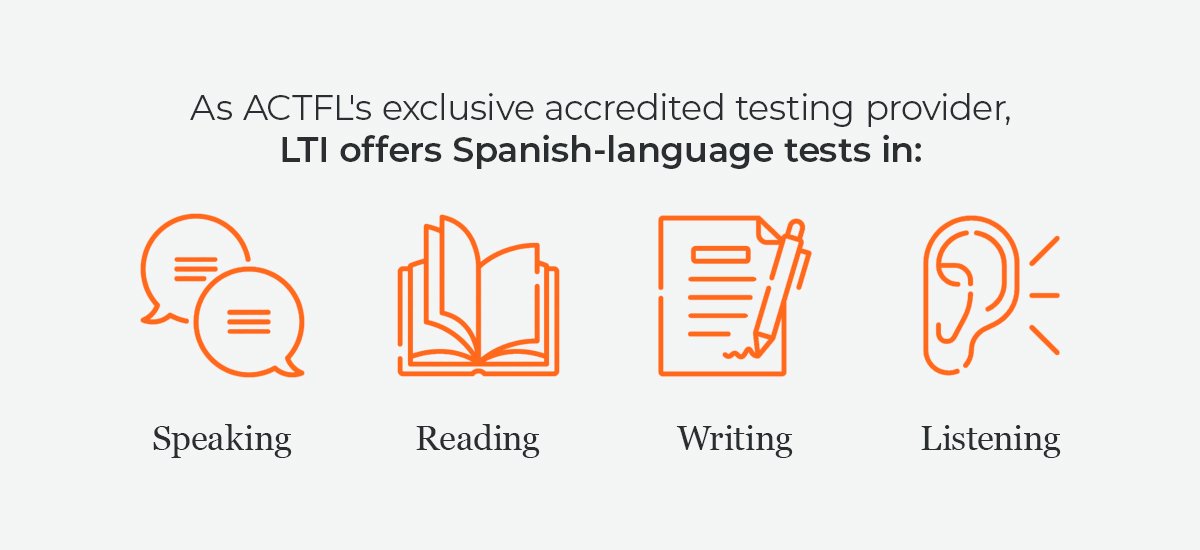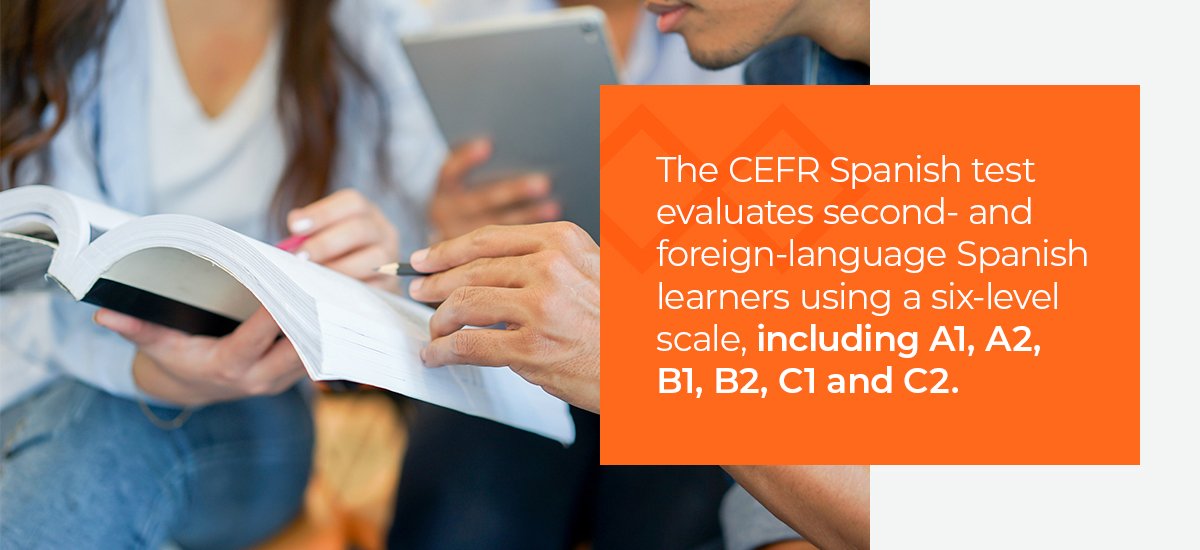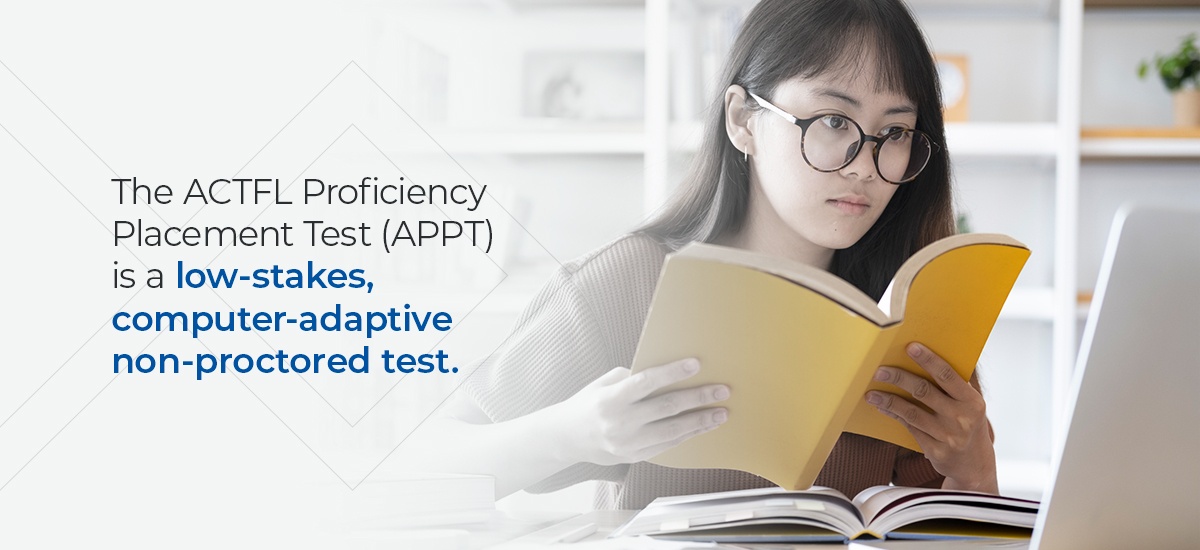Spanish Language Proficiency Testing

ACTFL’s recent Making Languages Our Business report highlights the need for Spanish speakers in the workplace. According to the report, Spanish is the most in-demand second language. 85% of surveyed United States employers indicated a need for Spanish-speaking candidates, with 34% reporting that their needs are not presently met by their employees.
In 2017, there were over in Spanish classes in the U.S. education system. In 2020, nearly 170,000 high school students enrolled in a Spanish Language Advanced Placement course. U.S. Census data shows that the over 41.7 million people who speak Spanish at home make up roughly 13.5% of the U.S. population.
Employers, schools, students, and job seekers all have reasons to evaluate Spanish comprehension, writing, and speaking skills. Employers must verify that their applicants have the ability to communicate with Spanish-speaking customers and letting applicants know that a language certification is needed can go a long way in ensuring the need is met. Likewise, job seekers need an employer-recognized Spanish language certification. Schools placing students in language classes seek the ability to distinguish between beginner and advanced Spanish learners. Advanced and intermediate students may also want to place out of and receive credit for a beginner-level Spanish class.
Language Testing International (LTI), the exclusive licensee of ACTFL assessments, delivers language assessments in over 120 languages, including Spanish proficiency exams. ACTFL assessments can help to address these needs with Spanish proficiency tests for all ages and skills, including Spanish oral and writing proficiency tests, Spanish reading tests, Spanish listening tests, and more. Learn more about ACTFL’s Spanish language certification options and LTI's remotely proctored testing services.
Spanish Proficiency Tests
ACTFL assessments include a range of tests and scoring options to align with your Spanish level. Test yourself, your students, your candidates, or your employees in Spanish listening, reading, writing, and speaking abilities. ACTFL assessments and the ACTFL Proficiency Scale are widely recognized and independently validated as an accurate measure of real-world language skills. Please read on to learn more about ACTFL’s Spanish assessments, delivered by LTI.

ACTFL Assessments for Spanish
Founded in 1967, ACTFL is an organization dedicated to language teaching and learning. Its more than 13,000-strong membership includes language educators and administrators. Besides supporting language teachers, they develop the industry's leading language proficiency assessments. ACTFL assessments are research-backed and internationally recognized. Schools and workplaces trust the ACTFL standards for Spanish to test students' and employees' language skills.
ACTFL assessments, delivered exclusively by LTI, can test Spanish ability in:
- Speaking
- Reading
- Writing
- Listening
Each Spanish fluency test can be used to accurately evaluate a person's Spanish proficiency. For teachers and job seekers, an ACTFL rating provides a valid, defensible language credential. K-12 and higher education institutions also trust these tests for Spanish class level placement and to benchmark students’ progress. Many employers require an ACTFL credential for roles that require Spanish communication to be confident in their ability to meet the job’s communication requirements.

Spanish test-takers’ proficiency is rated as either Novice, Intermediate, Advanced, or Superior on the ACTFL scale, which further divides the first three levels into Low, Mid, and High sublevels. All of the tests below can be used to certify language proficiency according to the ACTFL scale.
- Oral Proficiency Interview (OPI): As the gold standard in oral language testing, the Spanish OPI is a 15-30 minute telephone interview. While for the test-taker it is like carrying on a conversation, it encompasses four structured phases during which candidates demonstrate their maximum sustained functional level. The interview begins with a warm-up, followed by level checks and probes, and ends with a wind-down. The conversation is recorded so two separate ACTFL-certified Testers/Raters can determine a score on the ACTFL scale in order to deliver an official rating. The ACTFL OPI is available in Spanish and well over 100 other languages.
- Oral Proficiency Interview — Computer (OPIc): The computerized OPIc is an on-demand internet or phone version of the OPI available in Spanish and 14 other languages. Rather than a live tester, an avatar conducts the interview with prompts that are tailored to the test-taker. ACTFL-certified Raters then assess the recording of the conversation to determine the rating.
- Writing Proficiency Test (WPT): The WPT specifically assesses Spanish-language writing abilities. It is available on-demand in 10 languages and in limited quantities in many more. A 20-80 minute assessment prompts the test-taker with questions that elicit different types and levels of written language. The prompts deal with practical, social, and professional topics that are familiar to the individual and of general and/or cultural relevance. The candidate must write a written response to all the prompts, which are then rated by certified ACTFL raters.
- Listening Proficiency Test (LPT): The LPT tests a person's listening comprehension in Spanish (and 10 other available languages) through a variety of listening passages. The test-taker listens to a number of passages related to a range of real-life topics and answers multiple-choice questions. This 50-125-minute test is machine scored.
- Reading Proficiency Test (RPT): The RPT uses written passages to assess reading comprehension in the Spanish language (as well as 11 other languages). It requires that the candidate read a number of passages and review associated multiple choice questions, selecting the most appropriate answers. This 50-125 minute Spanish reading test is also machine scored.
- ACTFL Proficiency Placement Test (APPT): The APPT is a higher education placement test for Spanish and French students. It's a 60-minute, computer-adaptive reading and listening proficiency test. It includes the Interpretive Listening and Interpretive Reading modes and measures learners’ language abilities from the Novice Low to Advanced Low levels, with separate ratings provided for each mode. Colleges and universities can use it to place incoming students in the appropriate course.
- K-12 ACTFL Assessment of Performance toward Proficiency in Languages (AAPPL): Specifically for elementary, middle, and high school students, the AAPPL tests Spanish ability in three communication modes: Interpersonal Listening and Speaking, Presentational Writing, and Interpretive Reading and Listening in Spanish and 12 other languages.
- Basic User
- Independent User
- Proficient User
- OPI
- OPIc
- WPT
- LPT
- RPT
All ACTFL tests are rated by ACTFL-certified Raters who undergo a rigorous training and certification process followed by frequent renorming activities and whose performance, based on measures such as their interrater reliability, is constantly monitored. These exacting standards ensure all ACTFL tests offer valid and reliable results.
Tests are rated according to the ACTFL Proficiency Scale, however, you may also request a score conversion to the Common European Framework of Reference for Languages (CEFR) or the Interagency Language Roundtable (ILR) scales. ACTFL assessments have been favorably reviewed for college credit and are trusted by commercial and international organizations and government agencies to evaluate their staff or applicants' linguistic abilities.
CEFR Scale and Levels for Spanish Testing
Some organizations and schools with global ties may wish to use a rating system other than the ACTFL Proficiency Scale. It is possible to request a score conversion for many ACTFL tests to the Common European Framework of Reference for Languages (CEFR) Scale. The CEFR is a language testing framework widely used throughout Europe and around the globe. It provides an objective common basis to test individuals in second language education. It can also help language educators evaluate curricula, textbooks, courses, and tests.

The CEFR Scale evaluates test-takers on learning outcomes based on what they can do in the language. It also uses three dimensions, including language activities, their domains, and the competencies people draw on when they engage in them. The model divides language activities into four modes — reception, production, interaction, and mediation. The domains include public, personal, educational, and professional.
The CEFR Scale evaluates second-language Spanish learners’ abilities across six levels: A1, A2, B1, B2, C1, and C2. These levels separate into three broader categories:
Upon request, scores on the CEFR Scale can be provided for the following ACTFL assessments:
ILR Spanish Testing
Many government agencies testing their personnel for Spanish competency use the Interagency Language Roundtable (ILR) scale. ACTFL is a long-time ILR member. ACTFL assessments in Spanish can be either administered and rated according to the ILR protocol or a conversion of ACTFL ratings to the ILR scale can be provided.

The 0-5 level ILR scale measures a test-taker's Spanish abilities. To receive an ILR rating, a test-taker must use an authorized language assessment, like ACTFL’s assessments delivered by LTI.
A score of 0 correlates to No Practical Proficiency, and a score of 5 equates to Native or Bilingual Proficiency. Each step in the scale assumes proficiency at the previous level. The rating system also uses "plus-level" designations, such as 0+ or 3+. Raters assign a plus when a user substantially exceeds the scored level without meeting the next level's requirements.
Upon request, LTI can issue ILR ratings on the WPT, RPT, LPT, OPIc, and OPI Spanish assessments.
LTI offers competitive, pre-negotiated rates to qualifying government agencies. These government agency clients include NASA, the United States Postal Service, and the U.S. Department of Defense. Please see our GSA Schedule for more information.
Spanish Testing for Organizations
Many companies need Spanish-proficient employees — from call centers and hotels to small businesses and Fortune 500 companies. The Spanish-speaking population in the U.S. continues to skyrocket. Firms that can serve these customers in their first language will have an advantage. We offer reliable, remotely proctored Spanish-language testing to assess employees and future employees.
Job seekers can also use ACTFL tests to certify their Spanish skills. A high score can help job hunters stand out in the applicant pool, even when employers don't require language testing. ACTFL offers Spanish language proficiency certifications online for bilingual teachers and other professionals. Get certified for your speaking, reading, writing, or listening skills, depending on your professional goals.

Pre-Employment Spanish Testing
When hiring for a role that requires Spanish-speaking abilities, companies need a standard, proven evaluation system. Internationally recognized ACTFL testing can be used as a pre-employment screening tool.
It's challenging to get a comprehensive picture of a candidate's language abilities through a resume. Even a conversation with a multilingual interviewer isn't always indicative of future performance and can often introduce bias into the process. Hiring managers need an objective testing method that helps them to understand each candidate's level of proficiency.
ACTFL's research-based assessments are the industry-leading pre-employment Spanish proficiency testing method. They can help you screen or pre-qualify candidates efficiently and early on in your hiring process. With ACTFL ratings, you can move forward with confidence knowing that your candidates have the Spanish language skills you need.
LTI can also work with you to set an appropriate minimum proficiency score. Through a formal LTI Task Analysis procedure, we can recommend a suitable and legally defensible minimum proficiency level for the role you're hiring for. The data-driven process involves surveys, discussions, and other customized activities to determine what your team needs. LTI analysts uncover the content areas, context, degree of accuracy, and amount of elaboration you need from your Spanish-speaking employees.
In a competitive hiring landscape, remote proctoring is another advantage. Job candidates can test online or over the phone on their own schedule with no need to go to an in-person testing facility. By making the hiring process easier on candidates, you'll keep your candidate pool open.
We also offer similar services for government agencies that employ Spanish speakers. We can provide the same reliable tests, scored according to the federal government's preferred language rating system, the ILR scale.
Academic Spanish Testing
Schools from elementary to university level need objective Spanish testing for students. Some use ACTFL tests to place students in appropriate class levels. Using ACTFL testing at the start of a course can give teachers valuable insight into their students' current abilities and help them to establish learning outcomes. A post-assessment can evaluate individual students' progress and tell teachers how effective their teaching style, curriculum, and course materials are.

Graduating high school and incoming college students can use ACTFL testing to place out of college Spanish courses. Many institutions grant college credit for certain scores based on ACE credit by examination recommendations. Students can save money by testing out of required Spanish courses.
AAPPL Spanish Test
For students in grades 3 through 12, the ACTFL Assessment of Performance toward Proficiency in Languages (AAPPL) tests a range of Spanish skills. The AAPPL is based on the World-Readiness Standards for Language Learners and assesses Interpersonal Listening and Speaking, Presentational Writing, and Interpretive Reading and Listening. It challenges students to use their Spanish skills in real world scenarios such as video chatting and sending emails.
Elementary, middle, and high school students take the AAPPL online with a variety of available proctoring modes, depending on the needs of each school. They engage in various Spanish language tasks with personal, social, and academic significance across the three communication modes. The AAPPL is used to assess students in grades 5 through 12. AAPPL Elementary includes age-appropriate content for the assessment of 3rd and 4th graders. On both the AAPPL and the AAPPL-E, students receive scores ranging from N-1 to A-1. N-1 to N-4 correspond with the Novice range on the ACTFL scale, I-1 to I-5 with the Intermediate, and A-1 is aligned with Advanced Low.

Schools can choose whether to administer a Novice-to-Intermediate or Intermediate-to-Advanced test form. Form A includes three Novice-level tasks and three Intermediate-level tasks. Form B includes three Intermediate-level tasks and three Advanced-level tasks. Based on their scores on the AAPPL Form B and local and state requirements, high school students may earn a Seal of Biliteracy in Spanish.
Spanish teachers can use the AAPPL to establish baselines and track progress by administering the test or different test components at the start of a new school year or at key points within their curriculum. The added scoring distinctions provided with each AAPPL Score Report give teachers greater visibility into student progress over time and make it easy to track proficiency level.
For example, scores of I-1 to I-3 all correspond with Intermediate Mid. Tracking movement within the sublevel helps schools understand whether their Spanish programs are reaching benchmarks. Curriculum designers can use them to align learning objectives with real-world student communicative ability. Schools can also use them to award course credit or program placements for Heritage Spanish speakers.
Spanish Testing for College Students
The ACTFL Proficiency Placement Test (APPT) is a low-stakes, computer-adaptive, non-proctored test. Specifically designed for incoming first-year college students, the test measures students' reading and listening abilities. It includes text and audio passages and related questions spanning the Novice-Low to Advanced-Low proficiency levels. While the test in its entirety can take up to 60 minutes, each question has a 75-to-120-second time limit. The computer-adaptive system administers between 10-25 questions, depending on the test-taker's ability as demonstrated through their responses to the test items.

Higher-education institutions can use the ACTFL Proficiency Placement Test in Spanish for many purposes, such as qualifying students for acceptance into an institution or Spanish language program. Schools can use them for placement in general education language classes or for program benchmarking and evaluation. Since the test is non-proctored, it's best for low-stakes purposes.
In addition to the APPT, many universities have approved ACTFL assessments for college credit based on recommendations from the American Council on Education (ACE). The tests colleges typically accept for credit include the OPI, OPIc, WPT, LPT, and RPT. These assessments let incoming students earn credit for previous schoolwork or language learning through non-traditional means. Heritage Spanish speakers or students returning from time abroad can use these tests to earn credit for their language abilities.

Find Spanish-Language Assessment Solutions From LTI
Language Testing International is the exclusive Licensee of ACTFL for language testing. The ACTFL OPI, OPIc, WPT, LPT, and RPT are all available in Spanish, as well as the AAPPL and APPT Spanish tests for educational institutions. Official ACTFL Spanish proficiency exams are scored according to the ACTFL scale; we can issue ratings on the CEFR or ILR scales, depending on your needs. Schools, government agencies, and businesses can test their applicants, current employees, or students using any of these Spanish language tests, based on their unique needs. We help you eliminate the guesswork from placing students or screening job candidates.
Wondering how to get a Spanish certification as an individual? ACTFL's testing services are a great option. Spanish teachers, interpreters, and other bilingual job seekers can use a certification to verify their credentials and stand out on job applications. Students can earn certifications for college credit or place out of lower-level Spanish classes. Take ACTFL’s convenient, remotely proctored Spanish assessments online and on your own schedule to demonstrate your Spanish proficiency level. With an employer-trusted Spanish language certification, you can qualify for bilingual jobs and start earning more.
To learn more about our testing options for organizations, contact our sales team today. To schedule a language skills test for yourself, explore our certifications for individuals.

